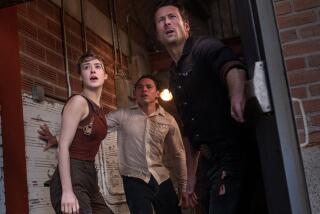Gusto on a Gimbal
- Share via
How do you coax a moving performance out of a storm-tossed 747?
That was the big question facing the filmmakers behind MGM’s forthcoming “Turbulence,” in which a lone flight attendant must fight off an escaped convict while attempting to fly the giant aircraft through the unfriendliest of skies. While stars Lauren Holly and Ray Liotta could be counted on to hit their marks and deliver their lines, finding a 747 that could accurately simulate various moments of aerial peril was more of a challenge.
That challenge was accepted by the film’s special effects coordinator, Al Di Sarro. Having contributed the very convincing submarine pitches and rolls to “The Hunt for Red October” and “Crimson Tide,” Di Sarro had become something of a specialist in creating large vessels in distress. In both of those films, the distress was made possible by gimbals--giant mechanisms capable of rotating scale models or pieces of sets--and Di Sarro believed his gimbal technology could successfully make the move from subs to jumbo jet.
But to create believable shakes and shudders for the film’s ill-fated 747, Di Sarro had to work big. So, he went to work constructing four of the largest gimbals ever used in film production. The largest of the four, the rotisserie gimbal, is composed of seven rings measuring 35 feet in diameter, and its construction alone required 150 tons of steel. The computer-controlled device can smoothly and precisely rotate a 70-foot section of plane mock-up--75,000 pounds of set. In 10 seconds, that whole set can be spun 360 degrees.
“What made this a special challenge was that it hadn’t been done before,” Di Sarro explains. “There had been similar rotisseries you could put a car or a small room in--but never 70 feet of plane. No one had gone this big. To get it built, we actually had to rip out the floor of the sound stage, dig out six feet of dirt, and pour concrete supports for the thing.”
The other gimbals include two large platforms that can raise, drop and shake their sets, and one lengthy mechanism filling most of two sound stages that can simulate extreme turbulence on a 170-foot section of plane. Before any of these were built, there were months of meticulous design and computer testing, but Di Sarro admits that after construction he couldn’t be absolutely certain that his gimbals, especially his giant rotisserie, would deliver.
“There were a lot of tense moments in the building of it--a lot of questions. We’d finish a part of it and think, ‘Gosh, I hope that’s going to work.’ Even though the computer’s telling you you’re doing the right thing, going from a piece of paper to 150 tons of steel is a big jump.”
On a recent afternoon at the Culver City sound stages where the gimbals are housed, the rotisserie is having no trouble creating some moments of in-flight terror. Holly, looking appropriately frantic and disheveled, is bouncing her way through the 70 feet of cabin as the gimbal rocks everything--set, actress, film crew--by rapidly pitching 45 degrees to the left and right. The only stationary object amid the frenzy is the camera, which is mounted on the end of a 40-foot computer-controlled crane arm.
In the film, a full 360-degree rotation will be seen only once--creating the impression that in the ongoing storm’s worst moments the 747 does a complete barrel roll. But to get those shots, the gimbal--and a group of brave stuntpersons--had to be spun numerous times. And Di Sarro says he felt a bit like a proud papa watching his creation do its job.
“The 360s were the biggest big moment,” he says with a smile. “Because basically, after all this effort, there was a time when it had to work. The bottom line was that it had to roll over for us. I’ll admit that when it made its first 360, I got a little puckered up watching it. That was a very nice surprise. It was very gratifying.”
That’s not to say that a long day spent with 150 tons of rotating steel doesn’t have some strange side effects.
“Well, it can be a little disorienting,” Di Sarro says with a laugh. “Whether you’re actually working on the gimbals or just watching them, it takes its toll on your equilibrium. It’s nice to go home and be as still as possible.”
More to Read
Only good movies
Get the Indie Focus newsletter, Mark Olsen's weekly guide to the world of cinema.
You may occasionally receive promotional content from the Los Angeles Times.








